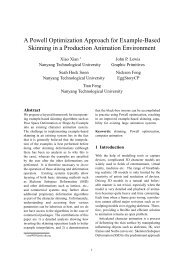Fast Normalized Cross-Correlation - JP Lewis
Fast Normalized Cross-Correlation - JP Lewis
Fast Normalized Cross-Correlation - JP Lewis
You also want an ePaper? Increase the reach of your titles
YUMPU automatically turns print PDFs into web optimized ePapers that Google loves.
other multi-resolution representations using a coarse-tofine<br />
multi-resolution search. Multi-resolution techniques<br />
require, however, that the images contain sufficient low<br />
frequency information to guide the initial stages of the<br />
search. As discussed in section 6, ideal features are sometimes<br />
unavailable and one must resort to poorly defined<br />
“features” that may have little low-frequency information,<br />
such as a configuration of small spots on an otherwise<br />
uniform surface.<br />
Each of the approaches discussed above has been advocated<br />
by various authors, but there are fewer comparisons<br />
between approaches. Reference [19] derives an optimal<br />
feature tracking scheme within the gradient search<br />
framework, but the limitations of this framework are not<br />
addressed. An empirical study of five template matching<br />
algorithms in the presence of various image distortions<br />
[4] found that NCC provides the best performance<br />
in all image categories, although one of the cheaper algorithms<br />
performs nearly as well for some types of distortion.<br />
A general hierarchical framework for motion tracking<br />
is discussed in [1]. A correlation based matching approach<br />
is selected though gradient approaches are also<br />
considered.<br />
Despite the age of the NCC algorithm and the existence<br />
of more recent techniques that address its various shortcomings,<br />
it is probably fair to say that a suitable replacement<br />
has not been universally recognized. NCC makes<br />
few requirements on the image sequence and has no parameters<br />
to be searched by the user. NCC can be used ‘as<br />
is’ to provide simple feature tracking, or it can be used<br />
as a component of a more sophisticated (possibly multiresolution)<br />
matching scheme that may address scale and<br />
rotation invariance, feature updating, and other issues.<br />
The choice of the correlation coefficient over alternative<br />
matching criteria such as the sum of absolute differences<br />
has also been justified as maximum-likelihood estimation<br />
[18]. We acknowledge NCC as a default choice in many<br />
applications where feature tracking is not in itself a subject<br />
of study, as well as an occasional building block in<br />
vision and pattern recognition research (e.g. [3]). A fast<br />
algorithm is therefore of interest.<br />
4 Transform Domain Computation<br />
Consider the numerator in (2) and assume that we have<br />
images f ′ (x, y) ≡ f(x, y)− ¯ fu,v and t ′ (x, y) ≡ t(x, y)−<br />
¯t in which the mean value has already been removed:<br />
num<br />
γ (u, v) = �<br />
x,y<br />
f ′ (x, y)t ′ (x − u, y − v) (3)<br />
For a search window of size M 2 and a feature of size N 2<br />
(3) requires approximately N 2 (M − N + 1) 2 additions<br />
and N 2 (M − N + 1) 2 multiplications.<br />
Eq. (3) is a convolution of the image with the reversed<br />
feature t ′ (−x, −y) and can be computed by<br />
F −1 {F(f ′ )F ∗ (t ′ )} (4)<br />
where F is the Fourier transform. The complex conjugate<br />
accomplishes reversal of the feature via the Fourier<br />
transform property Ff ∗ (−x) = F ∗ (ω).<br />
Implementations of the FFT algorithm generally require<br />
that f ′ and t ′ be extended with zeros to a common<br />
power of two. The complexity of the transform computation<br />
(3) is then 12M 2 log2M real multiplications and<br />
18M 2 log2M real additions/subtractions. When M is<br />
much larger than N the complexity of the direct ‘spatial’<br />
computation (3) is approximately N 2 M 2 multiplications/additions,<br />
and the direct method is faster than the<br />
transform method. The transform method becomes relatively<br />
more efficient as N approaches M and with larger<br />
M, N.<br />
4.1 <strong>Fast</strong> Convolution<br />
There are several well known “fast” convolution algorithms<br />
that do not use transform domain computation<br />
[13]. These approaches fall into two categories: algorithms<br />
that trade multiplications for additional additions,<br />
and approaches that find a lower point on the O(N 2 )<br />
characteristic of (one-dimensional) convolution by embedding<br />
sections of a one-dimensional convolution into<br />
separate dimensions of a smaller multidimensional convolution.<br />
While faster than direct convolution these algorithms<br />
are nevertheless slower than transform domain<br />
convolution at moderate sizes [13] and in any case they<br />
do not address computation of the denominator of (2).<br />
4.2 Phase <strong>Correlation</strong><br />
Because (4) can be efficiently computed in the transform<br />
domain, several transform domain methods of approximating<br />
the image energy normalization in (2) have been<br />
developed. Variation in the image energy under the template<br />
can be reduced by high-pass filtering the image before<br />
cross-correlation. This filtering can be conveniently<br />
added to the frequency domain processing, but selection<br />
of the cutoff frequency is problematic—a low cutoff may<br />
leave significant image energy variations, whereas a high<br />
cutoff may remove information useful to the match.<br />
A more robust approach is phase correlation [9]. In<br />
this approach the transform coefficients are normalized<br />
to unit magnitude prior to computing correlation in the<br />
frequency domain. Thus, the correlation is based only<br />
on phase information and is insensitive to changes in







